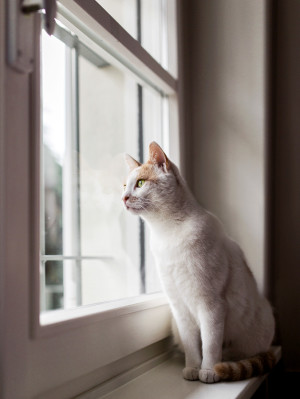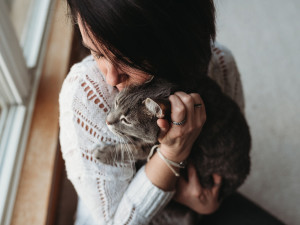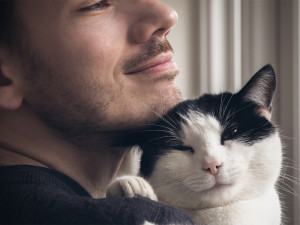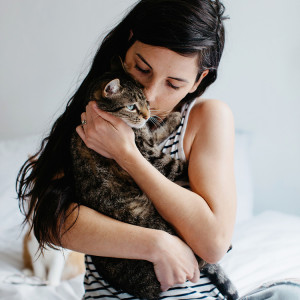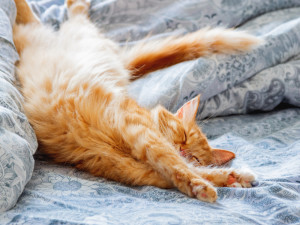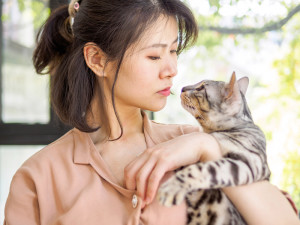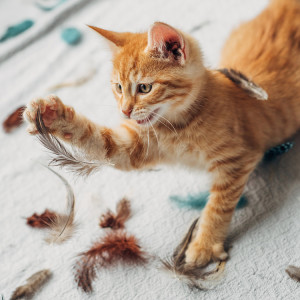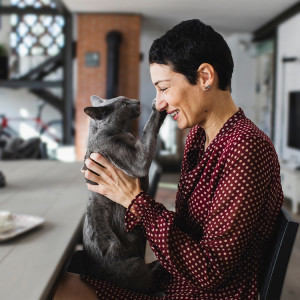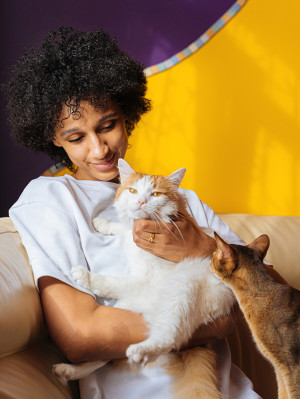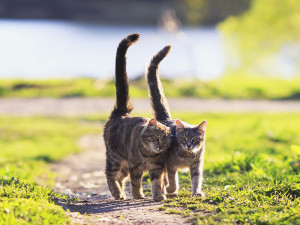How to Tell If Your Cat Has Depression
Or are they just being a cat? Here are some signs to look for.
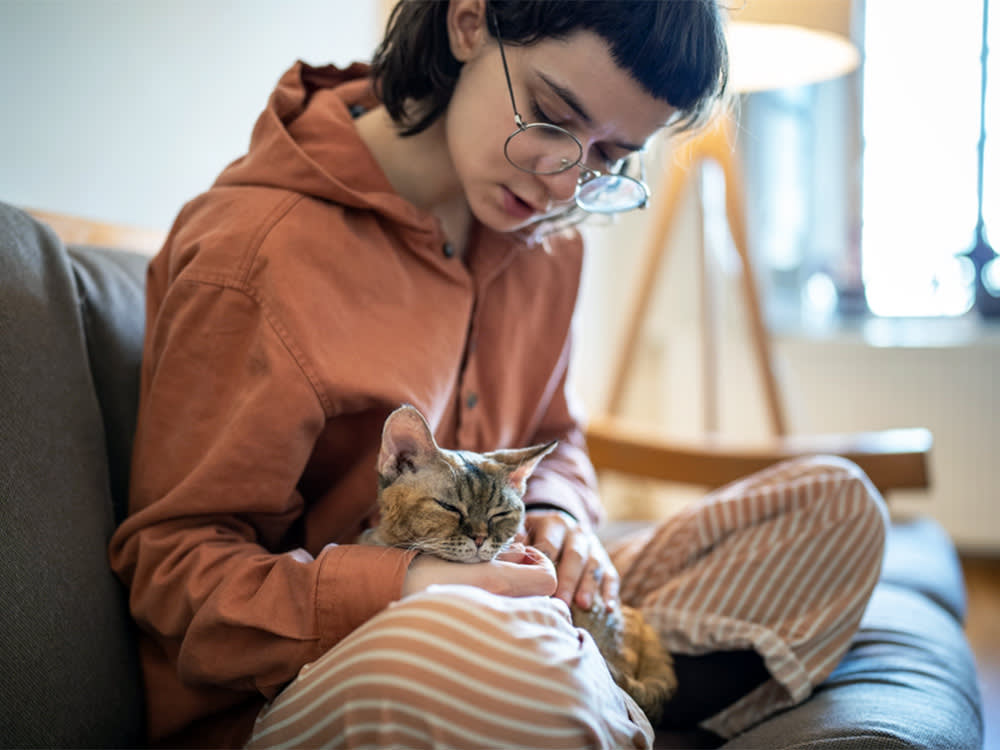
share article

Your pet wants you to read our newsletter. (Then give them a treat.)
In This Article:
Is My Cat Depressed? opens in a new tabHow to Tell if Your Cat is Depressedopens in a new tab Common Reasons for Depression in Catsopens in a new tab How to Help a Depressed Catopens in a new tab When Should You Consult a Vetopens in a new tab
Cats can definitely show signs of depression, and it’s important to take any major behavior changes seriously; they can also be a sign of underlying medical problems. In veterinary medicine, we focus on the signs we can observe and measure because cats cannot tell us that they are feeling sad or depressed.
And while they do experience signs consistent with depression, we tend to look at the behavior changes that seem consistent with distress, anxiety, and/or fear. And again, because cats cannot tell us how they are feeling, their behaviors can have mental causes, physical causes, or both. It is very important to observe your cat closely if they are acting differently and to report all of your observations to your vet.
Can cats get depressed?
Cats can become depressed for many reasons, usually attributed to factors in their surroundings. For example, a change in the household, such as the addition of another pet or person, can sometimes be distressing to a cat and lead to signs of depression. This can also happen from other situational changes, like moving to a new place, transitioning to living indoors, or a loss of another companion from the home. Really, any situation that causes ongoing distress for cats can lead to behavior changes consistent with depression. So, what does a depressed cat actually look like?
Signs your cat may be depressed
How can you tell if your cat is depressed — or just acting like a cat? The biggest clues to look for are changes in their behavior. If your cat has always slept 10 hours a day in an old Trader Joe’s bag inside a dark closet and is otherwise active, playful and healthy, this is no cause for concern. However, if your cat typically loves chin scratches and wakes you up for food at 4 a.m. but is suddenly hiding under the bed all day, not wanting to be touched and not crying for food, that is a red flag.
Where this gets tricky is that those kinds of behavior changes could be identical in a cat who is physically sick or a cat who is experiencing an upsetting event. You should never assume these kinds of changes are strictly behavioral unless you have had your cat checked out at the vet and all signs indicate that their physical health is just fine. That said, here are some of the most common signs of depression in cats:
Decreased appetite
Hiding or avoiding contact
Reduced interest in toys and activities that they used to love
Sleeping more
Changes in temperament such as becoming more aggressive
Urinating and/or pooping outside of the litter boxopens in a new tab
Decreased self-grooming
Signs of anxiety in cats
Many of us can probably relate to the fact that anxiety and depression often go hand in hand. When cats feel scared or anxious long-term, that kind of helplessness can lead to behavior changes associated with anxiety as well as depression.
Many signs of anxiety overlap with signs of depression because both often play a role in a cat’s behavior. As with depression, triggers for anxiety can include many situational stressorsopens in a new tab, such as the introduction of a new pet or person into the home, moving homes, unpredictable feeding schedules, separation anxiety opens in a new tabwhen left alone, scary sounds or smells, or the loss of a companion. If you can anticipate these situations, you may be able to provide some cat stress relief to help take the edge off. Here are some of the most common signs of anxiety and fear in cats:
Changes in appetite (either increased or decreased)
Loss of interest in toys and playing
Hiding
Staying awake more hours of the day
Acting hypervigilant about any new sounds, smells, or other stimuli
Changes in grooming behavior (decreased grooming or obsessively grooming)
Changes in temperament including acting more aggressive or scared
Common reasons for depression in cats
Cats often become depressed due to situational changes in the home or between their companions. Common reasons include:
Addition of a new pet or person into the home: Some of the most common ones we see occur when there is a new pet in the home that doesn’t jive well with your cat, especially rambunctious puppies or kittens, or a new person in the home like a new baby. This not only brings new smells and sounds but may also change certain routines and the amount of attention your cat receives.
Moving: Moving from life as an outdoor cat to live strictly indoors, or even just moving to a new home can be distressing for cats. Their familiar safe places and routines are disrupted and they can feel out of sorts as a result.
Changes in routine: Any big changes to the routine can be distressing to cats. This can happen if you suddenly have a new job and your hours change or if you travel more often.
Loss of a companion: The most heartbreaking one of all may be when your kitty loses a loved one. Just like us, they mourn and can be severely affected by the loss of a close companion, whether that is another pet in the household or a person.
Boredom: If your cat’s mental and physical enrichments are lacking, that can also lead to depression. Whether that stimulation previously came from life outside or from interacting with you or another furry companion or if they never had them to begin with, finding healthy outlets to keep their brain and body fit and engaged is crucial.
How to cheer up a sad cat
It is worth reiterating that your first step should be a visit to the vet if your cat is showing any of these signs or any other physical or behavioral changes. In many cases, there is an underlying medical problem causing these changes and once that is treated, your cat will be back to their normal, weird self. If there’s nothing physically wrong and you have reason to believe your cat is distressed for emotional reasons, here are some things to try at home:
Enrichment: Mental enrichment and physical exercise are crucial to your cat’s emotional wellbeing. If your cat is really withdrawn, it may take some time and patience to get them to engage. Start small and keep your expectations low. This may include activities like brushing your catopens in a new tab, using interactive cat dancer style toys, or even trying out a food puzzle. As your cat interacts more, continue to up the ante by providing lots of interactive toysopens in a new tab, climbing surfacesopens in a new tab, and scratching posts.
Calming pheromones: Pheromones are compoundsopens in a new tab released from the scent glands around a cat’s mouth, face, and paws and are part of why they are always rubbing their faces on things. There are products that contain synthetic versions of these compounds, which can be sprayed around the house, or even used in a diffuser to create a calm vibe for your cat. This can help if there are inter-cat aggression issues, if you are in an unfamiliar place, or if your cat is acting fearful or withdrawn.
Safe spaces: Often cats feel distressed if they are scared and don’t have good options for a safe space. This can happen if there is construction in the home, small children who haven’t learned good boundaries yet, or other pets who are too rambunctious for your cat. Give your cat their own quiet safe space where they can retreat when they feel scared. This could be a high shelf they can jump to, a closed-off room with a kitty door, or even a large box they can hide in. Ideally, give them food, water, and access to their litter box in their safe space so they can stay in there as long as they need.
Positive reinforcement: If your cat is withdrawn due to fear or changes in their routine, you can help them to gradually adjust using a reward system. This means that as they approach something scary to them, a new person, or come out of hiding a little, be sure to reward them with a favorite treat, some catnip, or a special toyopens in a new tab. Clicker trainingopens in a new tab can also help to reinforce these behaviors. The more positive experiences your cat has, the more likely they will start to overcome their anxiety and enhance their trustopens in a new tab.
When is it appropriate to call a vet?
Always. Seeking veterinary care is a very important first step any time you notice a big change in your cat’s behavior, especially if there are physical changes such as a change in appetite, change in weight, or changes in urinating or pooping patterns. Because any behavior or physical changes can be rooted in a medical problem, you’ll want to rule that out first. Treating any medical problems will be critical to helping your cat feel better, and to avoid more serious health consequences. Many times, once the medical problem is addressed, the behaviors also resolve.
Treatments for depression and anxiety in cats
Depending on the severity of your cat’s signs and the trigger, treatment will vary from basic interventions at home to more advanced work with a veterinary behavioristopens in a new tab and/or medications. Cats who are not eatingopens in a new tab as a result of their distress are the most concerning cases because they can get very sick very quickly from not eating. Some cats can develop a life-threatening liver condition called hepatic lipidosis (or fatty liver).
If your cat goes more than 24 hours without eating anything, be sure to contact your vet. These cats may need medications to stimulate their appetite and/or medications to reduce their anxiety in order to get through the crisis. Once they resume eating and have time to adjust to their situation, many cats can be weaned off of their medications with veterinary supervision.
For cats with more mild signs of distress or depression, you can utilize many of the home remedies above to help ease their distress and improve their wellbeing. It is also helpful to stick to a consistent routine when it comes to scheduling meals, playtime, and more so that your cat can rely on a predictable schedule.
If you know a distressing event is coming up, such as new people in the home, a move, a new pet, or travel, you can also speak with your vet about ways to ease those transitionsopens in a new tab. This may include more of the same strategies as listed above, as well as ways to gradually desensitize them to the change, and/or short-term medications that can help your cat stay calm during the transition. Luckily, most cats respond very well to these techniques.
FAQs (People also ask):
Is there medication for depression and anxiety in cats?
Yes. Most cats do not need long-term medication for depression but can benefit from short-term treatment during distressing times.
Can cats die from depression?
Cats who stop eating due to their distress can develop life-threatening complications. Any cat who goes more than 36 hours without eating needs to see a vet.
Can cats sense anxiety and depression in humans?
Cats become experts on their pet parents and can sense changes in a person’s routines, behaviors, and attitude.
References:

Dr. Amy Fox, DVM
Amy Fox, DVM is a small animal veterinarian in New York City. A lifelong animal lover, Dr. Fox studied biology in college and then worked as a veterinary nurse before pursuing veterinary school at Cornell University. She has worked in many different settings including shelter medicine, emergency medicine, general practice, and animal cruelty and forensics. She is especially interested in nutrition, preventative medicine and care for senior pets. Dr. Fox also enjoys writing about veterinary medicine and teaching. In her free time she loves to cook, garden, and go for long runs.
Related articles
![Cat stretching on blue bedding]() opens in a new tab
opens in a new tab5 Calming Products for Cats
Because New Year’s Eve is never a silent night.
![Cat looking at human]() opens in a new tab
opens in a new tabDoes Your Scent Actually Help Calm Your Cat?
They want you around more than your sweaty T-shirt in their carrier, but thanks for the thought.
![A cute orange tabby kitten playing with feathers.]() opens in a new tab
opens in a new tabIs “Orange Cat Behavior” Real?
Your TikTok algorithm would like you to think so, but the experts weigh in.
![Short haired woman holding a gray cat that's playfully pawing at her nose]() opens in a new tab
opens in a new tabDoes Your Cat’s Fur Pattern Determine Their Personality?
It’s a little more complicated than that.
![A woman with curly black hair sitting in front of a dark purple and yellow backdrop while looking down affectionately at her two cats sitting on her lap]() opens in a new tab
opens in a new tab7 Ways to Build Your New Cat’s Trust in You
If your cat still approaches you with a figurative arched eyebrow of skepticism, try these tricks to put them at ease.
![Two cats walking with their tails sticking straight up]() opens in a new tab
opens in a new tabCat Tail Meanings
Cats are enigmas. But their tail movements can reveal a lot about their moods.
